This project book is designed to be used alongside the EDIS document 4HMEM10, Starting and Maintaining a Marine Aquarium.
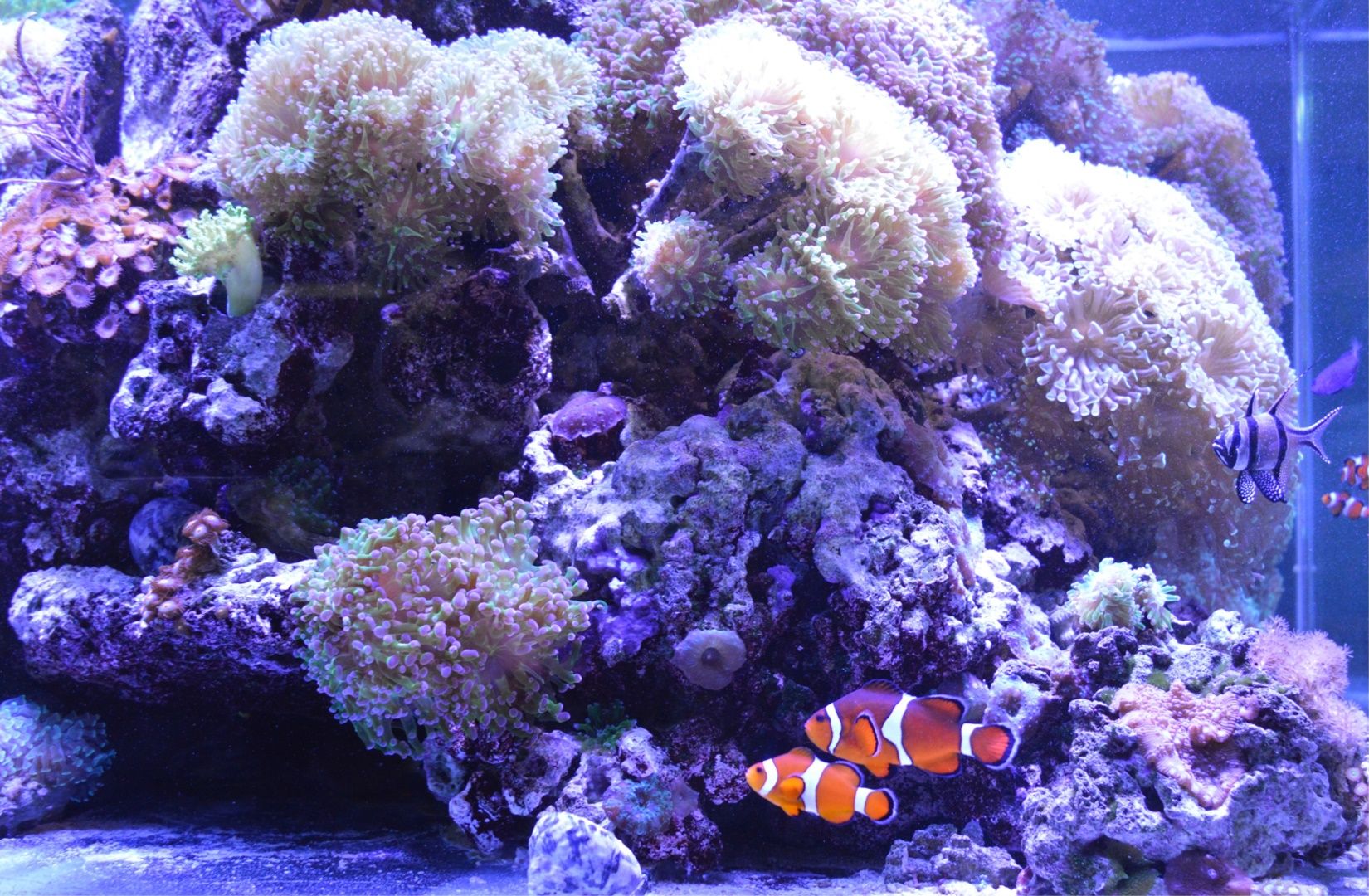
Credit: Prudence Caskey, UF/IFAS
Acknowledgments
Special thanks to Water World of Pensacola, Florida and the Georgia Aquarium in Atlanta, Georgia for allowing their subjects to be photographed.
This book was created as part of a non-thesis graduate project through the University of Florida, Institute of Food and Agriculture Science.
Writer/Editor: Prudence Caskey, UF/IFAS
Photography: Prudence Caskey, UF/IFAS
Table of Contents
- Introduction
- Selecting an Aquarium
- Essential Elements of the Marine Aquarium
- Activity One: My Aquarium Information
- Timeline for My Aquarium
- Day One: Setting Up the Aquarium
- Day Two: Understanding Filtration and Water Flow
- Day Three: Start the Nitrogen Cycle
- Activity Two: Nitrogen Cycle
- Week Three: Adding a Cleaner Crew
- Week Four: Mapping Out a Plan
- Week Five: Water Change and Affix Corals
- Selecting Corals
- Week Seven: Adding Additional Fish
- Fish Identification
- Week Eight: Testing Equipment
- What Am I Testing For?
- Specific Gravity
- Testing Forms
- Glossary
- My 4-H Story
- Project Photos
- Additional Resources
Introduction to Saltwater Aquariums
When deciding to begin the adventure of owning a marine aquarium, much consideration needs to be made. People in the marine aquarium hobby can be very helpful to answer questions and point you in the right direction. This project book is designed to be a guide for your journey. Before deciding to acquire a marine or saltwater aquarium, careful thought should be given to many different aspects of the aquarium project. You will need to determine the cost, size, time, and placement of the aquarium before beginning the project.
The cost of the initial purchase of the aquarium needs to be taken into consideration at the beginning of the project. The larger the aquarium, the more expensive the start-up and maintenance costs will be. The smaller the aquarium, the smaller margin of error you may experience with your tank. There are two sides of this thought process. With a larger tank, you will have higher costs, but with a smaller tank, you will have to make sure your system is stable more often. A cost and needs analysis should be performed before deciding which size tank you will use for this project. Please refer to page 7 to record the information regarding cost and needs analysis and the data for your aquarium system.
In this project book, we will discuss a 16-gallon and a 32-gallon nano or cube tank. These tanks are great for beginners because they are easy to set up and maintain. These tanks include all the filtrations and are truly a “reef-ready” type system. The maintenance will be easier with the larger tank. However, the initial cost of sand, water, and rock will be higher because more of the components will be required to establish a larger tank.
A marine aquarium requires more than 72 hours for the tank to acclimate before you will be able to add animals. A marine aquarium tank will need to go through a nitrogen cycle before fish or other animals can be added, which can take up to three to four weeks to complete. You will find more information about the nitrogen cycle covered in Activity Two: Nitrogen Cycle. In addition to the nitrogen cycle, your aquarium will be slowly becoming a “live” aquarium over the first several weeks.
A marine aquarium requires time and effort to maintain. The size of the tank will determine how much time and effort will be required. The larger the tank, the more it will cost to purchase and maintain, but the time required to maintain it will be reduced. For example, a 32-gallon aquarium needs a 25% (seven to eight gallons) water change every four weeks. A larger tank needs approximately the same 25% water change every four weeks. For example, if your tank holds 175 gallons, you will have to change nearly 44 gallons of water. The larger the tank, the more water you will have to handle. Also, the placement of the aquarium is vital. You will need to have access to a power outlet, and the aquarium should not be placed near a window or directly in the path of a heater or air-conditioning vent.
Selecting a Saltwater Aquarium
The most important things to consider when selecting a tank are cost and size. We will be examining two tank systems for this project book. With this initial project, you will be able to choose any size tank. The examples given will be for a 16-gallon or a 32-gallon nano or cube tank. These tank systems are “reef ready” and can be purchased for $300 to $550, depending on size. Larger systems are designed for a more advanced aquarist and should not be your first attempt at a marine or reef aquarium. The smaller systems make an excellent choice for beginners and soft corals. As you begin your project, it is a good idea to seek out a mentor for your project.
You may consider purchasing a used tank. If you purchase a used system, completely clean the system and do not accept any live rock or animals unless you have seen the tank set up prior to moving it. There are risks associated with purchasing used equipment. A used tank may contain bacteria or have experienced an uncontrollable algae outbreak. Carefully clean a used tank with a 20:1 mixture of water and distilled white vinegar. Make sure to rinse thoroughly after coralline deposits dissolve.
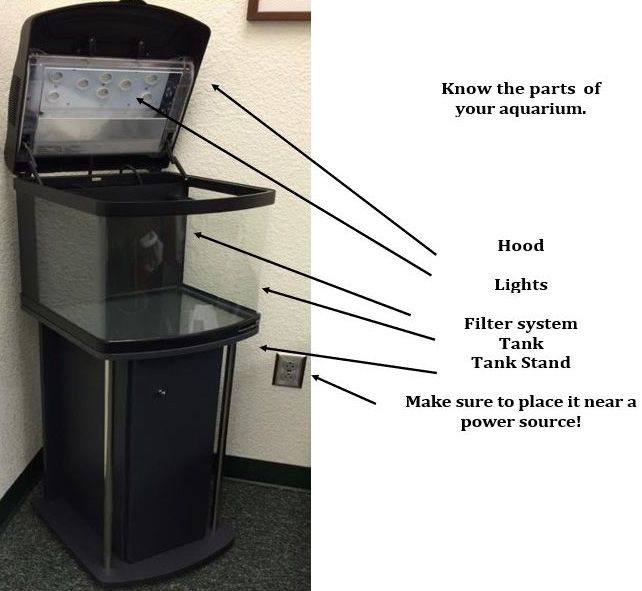
Credit: Prudence Caskey, UF/IFAS
Essential Elements of the Marine Aquarium
- Filtration—The aquariums we have selected to feature in this project book contain a filtration box that is included in the structure and built into the back of the system. This is a three-part system of suction, filtration, and output.
- Filter Media—The filter media is how the water is cleaned within the system. There are several types of media that can be used. If you are familiar with freshwater aquariums, charcoal and fiber are used. Charcoal can be used in salt water as well. The decision to use biological or chemical filtration should be made to assist with the cleaning. The system we will discuss comes with a biological filter media called Bio-Balls.
- Fish—The selection of fish is vital to the success of your aquarium. As tempting as it is to buy more expensive fish, it is best to begin with damsels or blue-green chromis. Clownfish are also extremely popular but can cost as much as $20 each. Always ask for assistance at your local fish store when selecting new fish. Some fish are considered “loners” and should not be placed with other fish. Also, some fish are paired with other animals. The pistol shrimp and watchman goby are an example of a symbiotic pairing. A symbiotic pairing means that both organisms benefit from the relationship as the shrimp’s home is guarded by the watchman goby.
- Heater—Most tropical fish and reefs will require a heater to maintain the tank at a constant 78°F.
- Lighting—Lighting is an essential element of the marine aquarium because a lot of the organisms and plants require lighting to thrive. A bio-cube system uses blue and white or 50/50 lights that will simulate sunlight. Lunar lights can be added to simulate moonlight. Lunar lights are not necessary; however, they can make viewing the tank at night easier.
- Powerhead—A powerhead or circulation pump will help to create a current in your tank, which will greatly improve your tank’s ability to thrive.
- Protein Skimmer—This equipment is a foam fractionator. In our mini-ocean, this is our version of seafoam. The skimmer will help to remove the foam and other impurities in the system.
- Rocks—Always be sure to use aquarium-grade rocks. Adding rocks from other sources could prove dangerous. Death of livestock or the introduction of unwanted hitchhikers could result.
- Sand—Sand is the base of the aquarium. Live sand with microorganisms can be purchased at most aquarium stores.
- Stand—The stand should be a base that is strong enough to handle the weight of the water, sand, and rocks. Stands are usually sold with the aquariums as a pair.
- Thermometer—The thermometer is a device that will measure the water temperature in the system.
- Water—Only reverse-osmosis (RO) water should be used in your tank. Never use water from the ocean because impurities could harm your aquarium’s inhabitants.
Cost/Needs Worksheet
The total budget for initial tank set up:
My Aquarium Information
Tank Manufacturer
Stand Type
Description of Tank Placement
Tank Size gallons
Type (Circle one) Glass Acrylic
Shape of Tank
Day Lights
Lunar Lights (if applicable)
Filter
Filter Medium
Powerhead
Protein Skimmer
Heater/Cooler
Thermometer
Sand
Pounds of Rock
Pounds of Live Rock
Calculate your tank weight.
Weight of stand + gallons of water × 8.6 =
+ pounds of sand + pounds of rock = My tank weighs pounds
Timeline for My Aquarium
Indicate on each line when each task was completed.
Week One:
Day One: Set up the tank with live rock, live sand, and water.
Day Two: Establish filtration and water flow.
Day Three: Tank should be completely clear with rocks and sand visible. Add first fish to initiate the nitrogen cycle.
Week Three: Add a cleaner crew.
A selection of snails, crabs, and other cleaners should be added to the tank this week.
Week Four: Mapping out a plan and water test.
Start to decide what you plan to have your tank look like and what livestock, if any, you want to add in week six.
Complete water test and record data. The nitrogen cycle should be complete. If not, wait until there are no nitrates in your system before proceeding.
Week Five: Change the water and affix the first coral.
Complete 25% water change.
Affix first coral to rock while water is drained.
Week Six: Coral Aquascaping.
Design a plan for affixing corals in the future as well as a plan for which livestock, if any, you will add.
Week Seven: Adding additional fish.
Complete water test and record data.
Add your first fish or livestock to the tank.
Week Eight: Ongoing maintenance and testing.
Complete 50% water change.
Complete water test and record data.
Day One: Setting up the Aquarium
The placement of the aquarium is vital. Make sure to avoid direct sunlight and placing the aquarium in the path of air conditioning vent. Also, make certain that the aquarium is placed near an electrical outlet. It will be very hard to move the aquarium once it is filled with water, rocks, and sand.
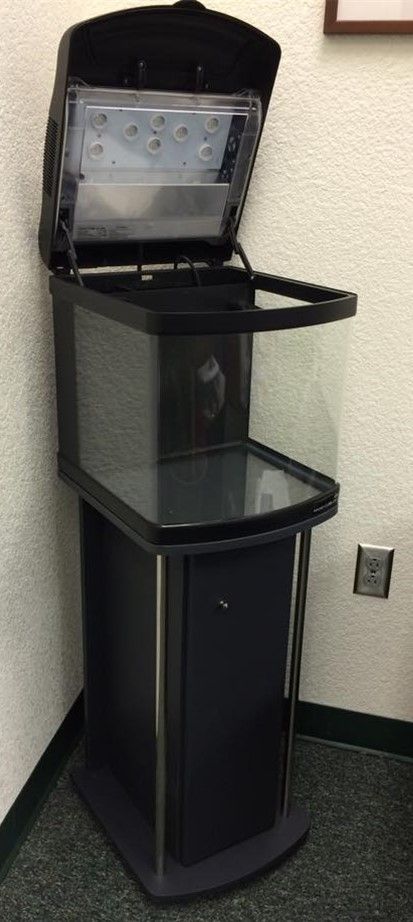
Credit: Prudence Caskey, UF/IFAS
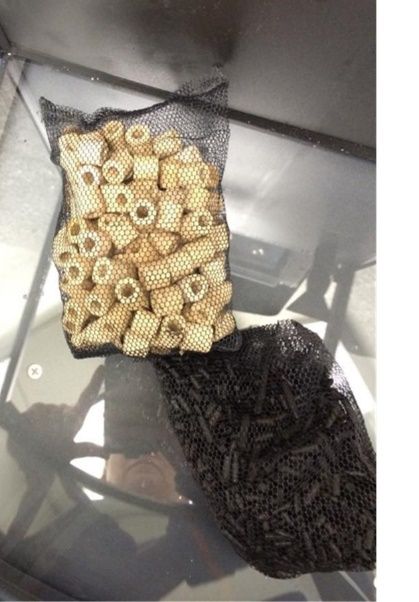
Credit: Prudence Caskey, UF/IFAS
Make sure you read all the instructions that come with your new aquarium. The media packets will need to be added to the back of the aquarium in the filter area. The filter system is explained in detail on the following page.
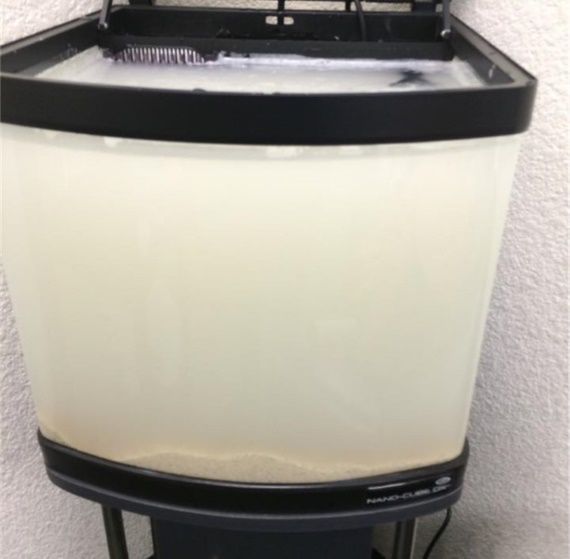
Credit: Prudence Caskey, UF/IFAS
Water, water, everywhere!
When selecting the water for your tank, only use reverse osmosis (or RO) saltwater. This water has been purified to the point where there are essentially zero total dissolved solids. This means there is nothing in the water to grow. Nuisance algae or cyanobacteria. Never use water from the ocean, bay, or sound.
Why so cloudy?
Don’t worry! It is perfectly normal to have milky water for the initial set up. If you are using live sand, the microorganisms in the sand will be stirred up and create water that looks dirty. The water will settle and be crystal clear by day two or three.
Day Two: Understanding Filtration and Water Flow
Let’s get to know the filtration system that came with your tank. Below is a picture from the Coralife Bio Cube Instruction Manual.
Chamber 1 is the input for the filtration system. Water is pulled through intakes on the back wall and travels through the filtration system.
This is where a protein skimmer or heater can be placed.
Chamber 2 holds your Bio-Balls and filter cartridge.
This is known as your wet/dry filter system.
Chamber 3 is where your water pump is housed.
This is also the output for your system.
The wet/dry return output will provide some water movement for the tank. It’s recommended to add additional movement with a powerhead or circulation pump. Powerheads are only for tanks over 20 gallons. A small circulation pump works great for the 12- or 14-gallon sized nano tanks.
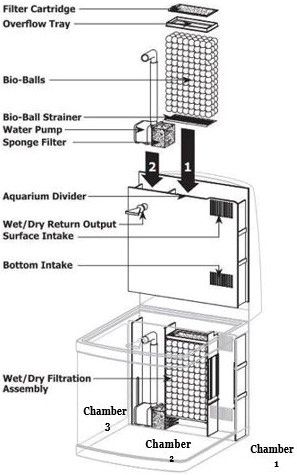
Credit: Coralife BioCube 32 Instruction Manual
Types of Filtration
Mechanical: Bio-Balls in chamber 2 provide your mechanical filtration.
Chemical: The Filter Cartridge is an activated carbon packet and is located on top of Chamber 2. This provides your chemical filtration.
Biological: Your live rocks and live sand will provide your biological filtration.
Day Three: Live Rocks and Sand Should be Visible!
This is a great time to adjust the rocks and make sure the sand is where you would like it.
The water flow will create a current in your system. Over the next few days, you can make minor adjustments to make sure that the flow is not blowing sand onto rocks. One of the problems with creating current is that a misplaced powerhead or circulation pump can create holes in the sand.
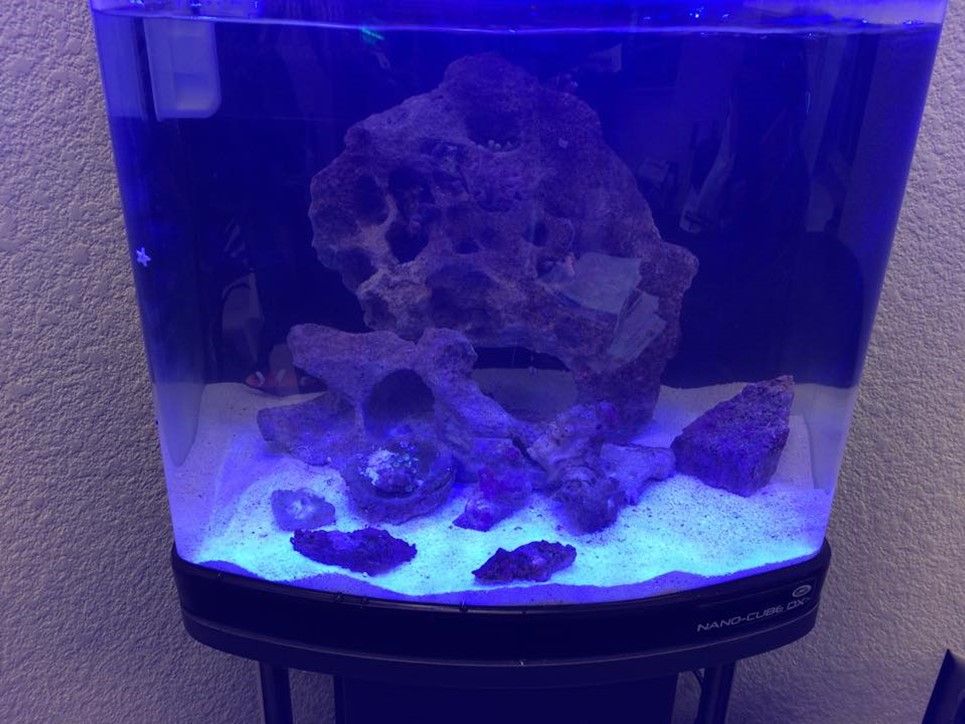
Credit: Prudence Caskey, UF/IFAS
Weeks 1-3: Nitrogen Cycle
Before we discuss how the nitrogen cycle works, you should watch the following videos: https://www.youtube.com/watch?v=xlgdyTpNHeo and https://www.youtube.com/watch?v=-dKPUyej5zk.
After your aquarium has been established for at least two weeks, you can initiate the nitrogen cycle: buy a “first fish.” This is usually an inexpensive fish to jump-start the nitrogen cycle. Damsels or chromis are a great initial purchase for this purpose.
Definition: The nitrogen cycle is the natural process through which nitrogen is incorporated into food by photosynthetic organisms. These organisms are consumed directly or indirectly by other organisms and subsequently excreted, acted upon by bacteria, and made available again for plant nutrition.
In an aquarium, the establishment of the nitrogen cycle is often referred to as the break-in cycle, start-up cycle, or cycling the tank. The cycle begins once fish or live bacteria are introduced into the tank. You should begin testing now; see page 22.
Use the letters of each step to label the diagram below.
A. Nitrates are naturally removed by changing the water.
B. Waste from fish creates ammonia (NH3).
C. Larger fish eat smaller fish and produce waste.
D. Smaller fish eat microorganisms in your tank and are known as the cleaner crew.
E. Phytoplankton and other microscopic organisms eat waste.
F. Bacteria eats the nitrites (NO2), which become nitrates.
G. Plants and phytoplankton use light to sustain life.
H. Nitrates (NO3) are created from ammonia by good bacteria on live rocks.
Label the Nitrogen Cycle.
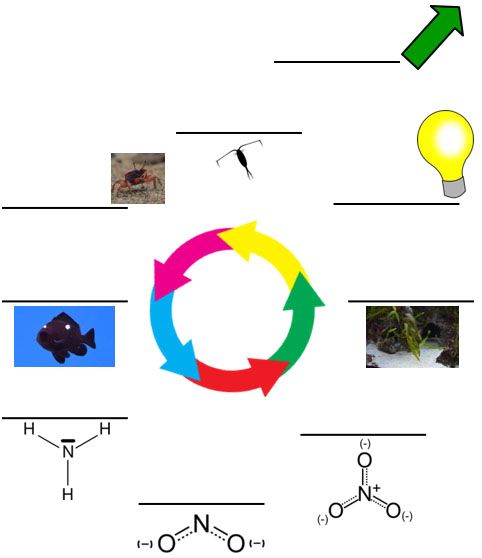
Credit: UF/IFAS
Week Three: Adding a Cleaner Crew
Adding your cleaner crew is vital to a healthy tank. These little creatures will help clean up your tank as soon as the nitrogen cycle is complete. Do not add them too soon. They eat what they clean, and if there is nothing to clean, there is nothing to eat. All the cleaners listed below are reef-safe.
Let’s get to know some cleaners!
Cleaner Shrimp
Cleaner shrimp are great little carnivorous scavengers. Always be careful which type you choose; not all cleaner shrimp are reef safe. This scarlet cleaner is a great reef-safe cleaner. Others include peppermint shrimp, sexy anemone shrimp, bumblebee shrimp and the colorful harlequin shrimp.
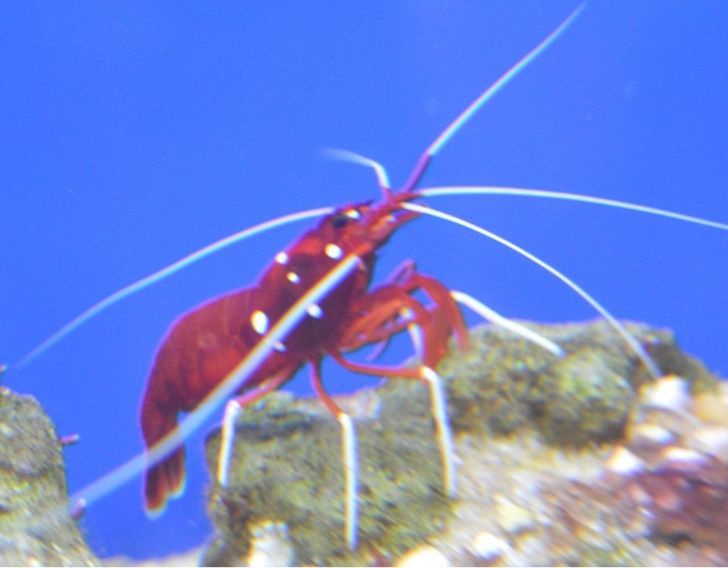
Credit: Prudence Caskey, UF/IFAS
Starfish
Not all starfish are reef safe. The best rule is that if they have long, skinny legs, they will do great in a reef system. The brittle and serpent stars make an excellent choice for reefs. The thick-legged chocolate chip starfish is one to avoid if you have corals. They will bulldoze their way through your tank and destroy your aquascaping!
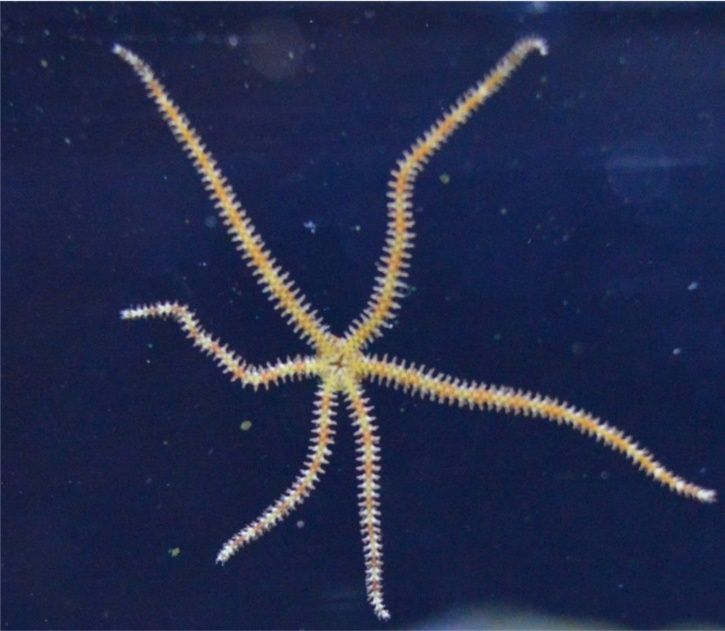
Credit: Prudence Caskey, UF/IFAS
Urchins
These are great cleaners for the glass. Be warned that they can eat all of the wonderful purple coralline algae you have been trying to grow on your live rocks.
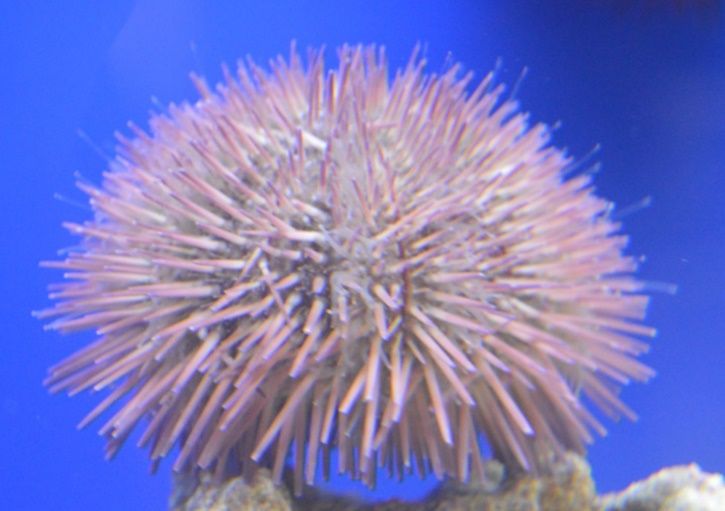
Credit: Prudence Caskey, UF/IFAS
Turbo and Astraea Snails
If your tank is under 50 gallons, only a few snails are needed to keep your glass crystal clear. A turbo snail (Figure 12) is a very large snail. These snails are about the size of a ping-pong ball. They may be too bulky for a small tank. Instead, several Astraea snails (Figure 12) would be a great substitution. They will both eat cyanobacteria and are hungry herbivores.
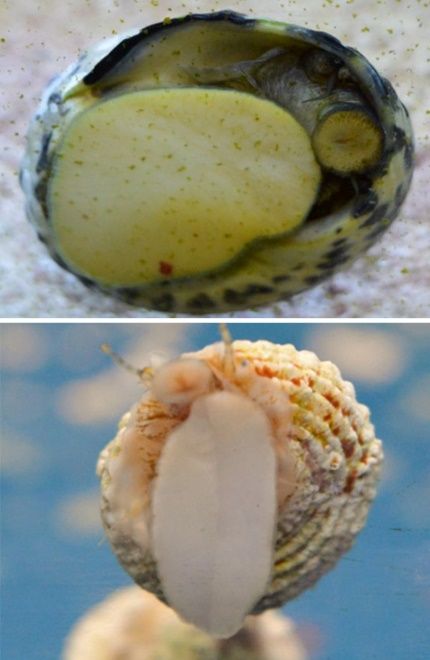
Credit: Prudence Caskey, UF/IFAS
Bumblebee Snails
These are wonderful ornamental snails. They will clean the sand as well because they like to burrow. They also love to eat detritus.
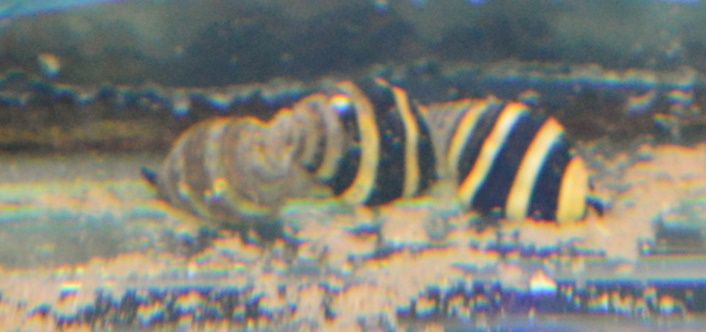
Credit: Prudence Caskey, UF/IFAS
Emerald Crab
These small crabs will clean a tank in a hurry. One problem that can arise with them is they will eat smaller fish and will move unattached corals. They are known as the bulldozers of the cleanup crew. They are not light-footed creatures, which can be annoying.
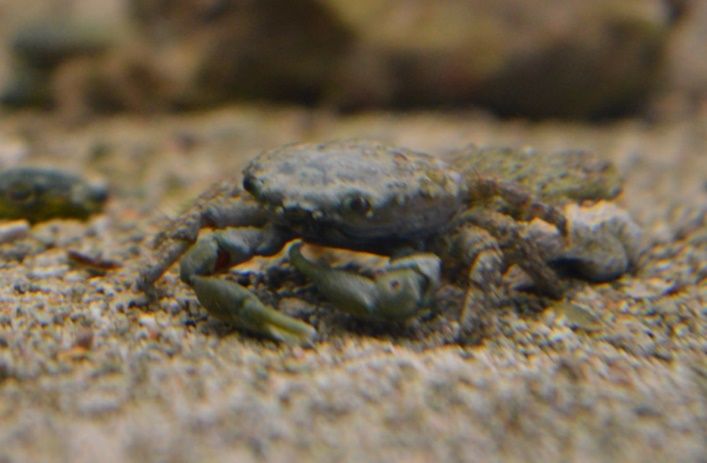
Credit: Prudence Caskey, UF/IFAS
Hermit Crabs
There is a huge variety of hermit crabs available. The trick is to make sure the one you choose is reef-safe. Blue- and red-legged, staghorn, blue knuckle, coral, and zebra-legged are all examples to choose from. They are tremendous cleaners and fun to watch.
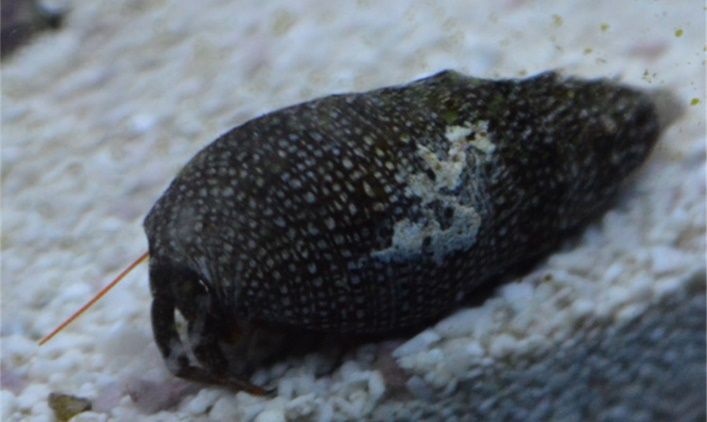
Credit: Prudence Caskey, UF/IFAS
Burrowing Crabs
These little guys are inexpensive and do a wonderful job cleaning the whole tank. They will even burrow into the sand to make sure it is clean.
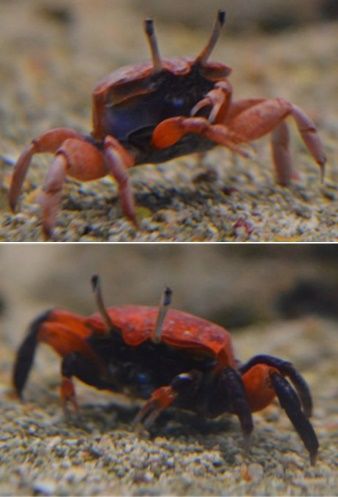
Credit: Prudence Caskey, UF/IFAS
Week Four: Mapping out a Plan
When determining what creatures or fish to add to your aquarium, you should think about your expectations for your tank. A reef system is very enjoyable and a fun underwater garden. If you prefer, a natural tank is also a great idea. Here are several ideas for tanks.
Some aquarists only want corals and some cleaners but never add a fish. The choice is up to you. Begin thinking about what you plan to do with your tank after the nitrogen cycle is complete. Visit fish stores for ideas and look online for inspiration.
Check with your local fish store to inquire if there is a marine aquarist club in your area. Many times, hobbyists will get together and hold a “frag swap,” which is a meeting where you can swap or purchase inexpensive corals for your tank. These members are also full of information and always willing to share.
Let’s compare these two photos (Figures 17 and 18). Figure 17 is a new tank set up at day three. Water is clear and flow is established. The live rock is positioned and the tank begins to grow. Below (Figure 18) we can see the well-established tank with several types of coral and livestock.
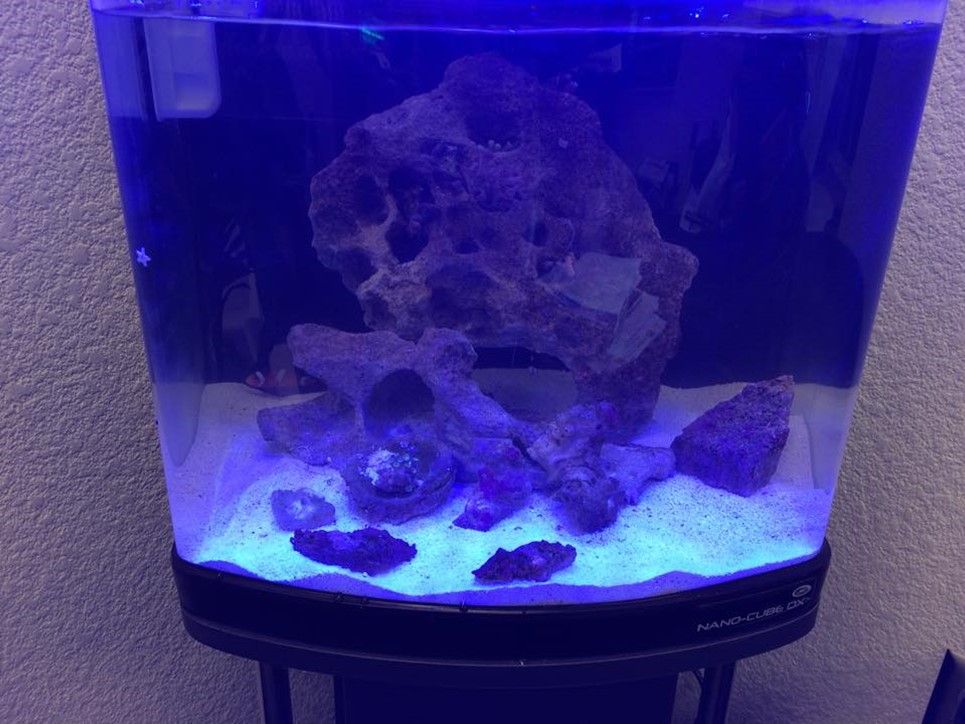
Credit: Prudence Caskey, UF/IFAS
This is the same tank one year and 10 months after initial set up. You can see how much it has changed! The coral will grow and change. You must allow for these changes when planning for your tank.
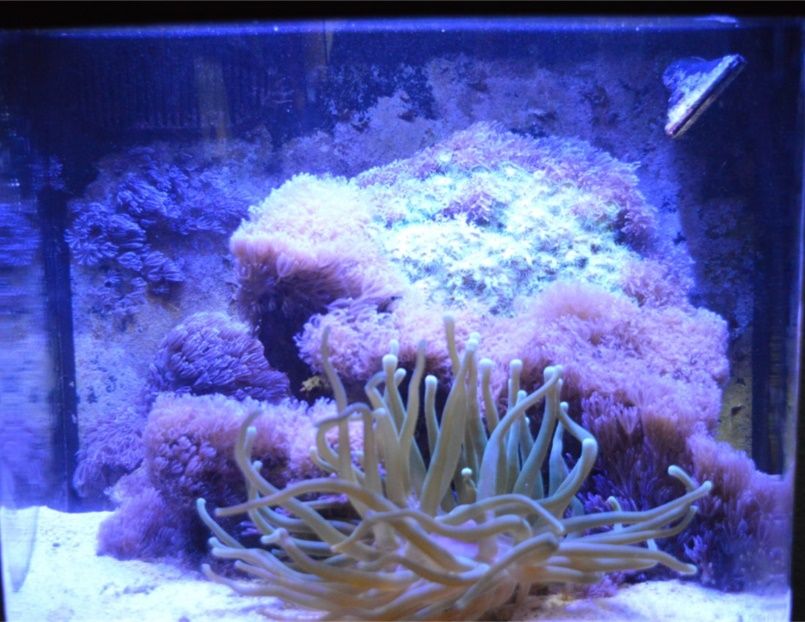
Credit: Prudence Caskey, UF/IFAS
This tank has no fish, and the only livestock are a snowflake moray eel and a pink-tipped anemone. Other fish would be eaten by the eel, because he will eat anything he can catch and that will fit in his mouth. This is not as easy as it sounds, because he is blind! Most fish would be safe from him if he weren't so fast.
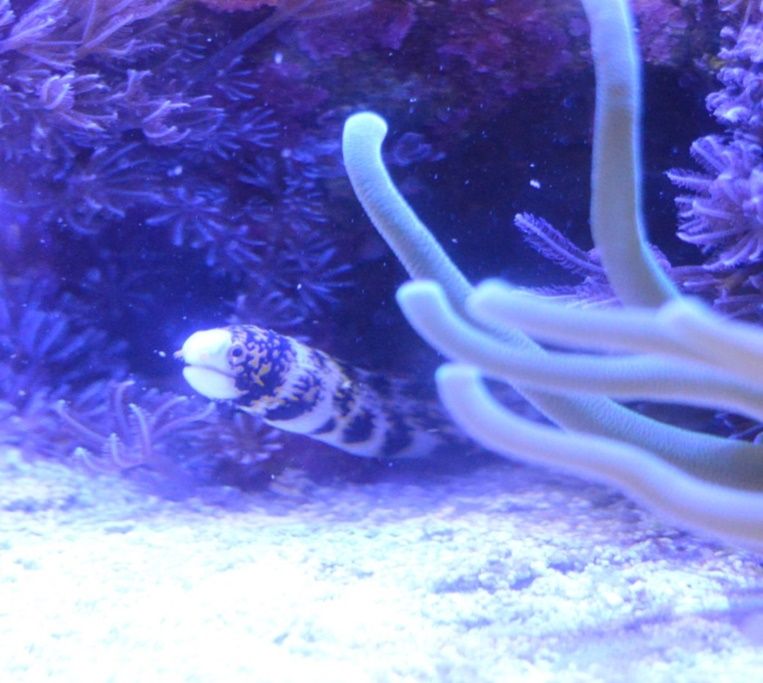
Credit: Prudence Caskey, UF/IFAS
Remember, it is a great idea to look at many other tanks before you start to buy corals. Once you decide what you want from your system, it will be more enjoyable if you have a result in mind and a goal to achieve.
Here is an example of a well-established reef tank.

Credit: Prudence Caskey, UF/IFAS
Can you name any of the corals in this picture?
Week Five: Change Water and Affix Coral
This week we will complete a water change and glue some coral in place while the water level is low enough to expose the rock.
First, syphon enough of the water to expose the rock you plan to glue onto. This may be as much as 75%. Remember, this is not 75% of 29 gallons, because the sand and rock take up a portion of the tank. In this case, it is about 13 gallons. This is also a good time to clean the sand and glass. Make sure to stir the water up before starting.
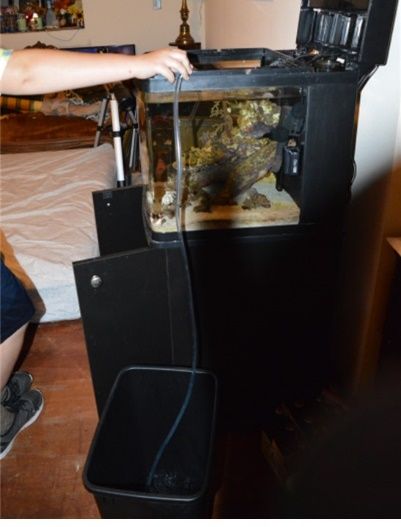
Credit: Prudence Caskey, UF/IFAS
When placing corals on your rock, hold the coral in place a few seconds after applying the glue. Many stores sell special glue for corals. Underwater putty is also available for hard or stony corals.

Credit: Prudence Caskey, UF/IFAS
Refill the tank water into the filter system. Pouring your water on your exposed rock and coral could be harmful to your animals living there. Pour slowly.
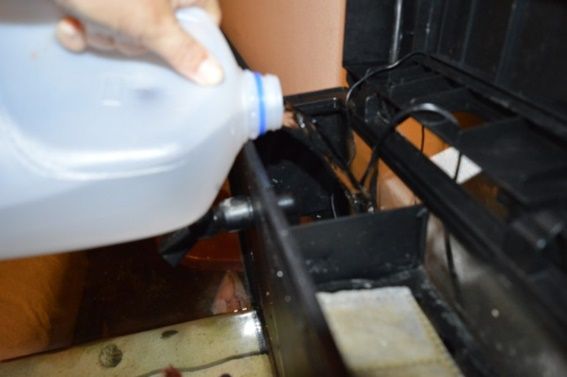
Credit: Prudence Caskey, UF/IFAS
After the tank is refilled, it may take an hour or two before the water clears up. Make sure to record the water change and always mark your calendar for the next water change. Good maintenance is the key to success with a saltwater tank.
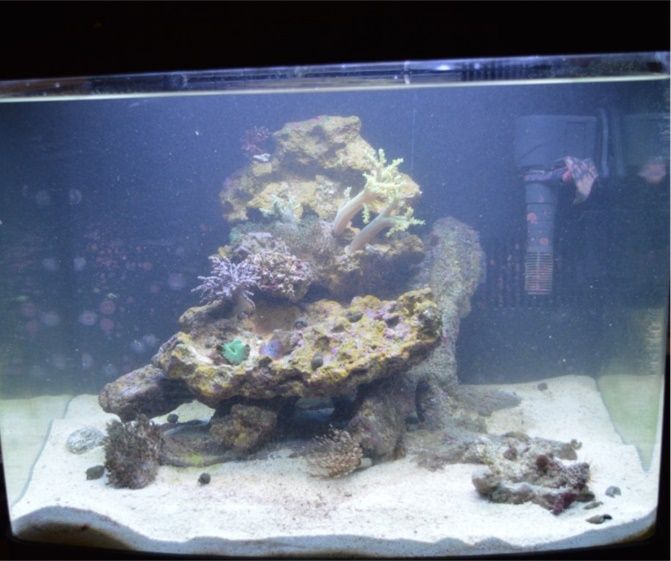
Credit: Prudence Caskey, UF/IFAS
Selecting Corals
Below are a few excellent corals for beginner tanks. As you and your system become more advanced, other corals can be added. Always remember that corals are alive and the group or colony that you initially purchase will not stay the same size. Start small and allow for growth in your tank.
Mushroom coral makes a very good beginner coral and will grow easily. Mushrooms also are available in many colors. They are not a fast-growing coral.
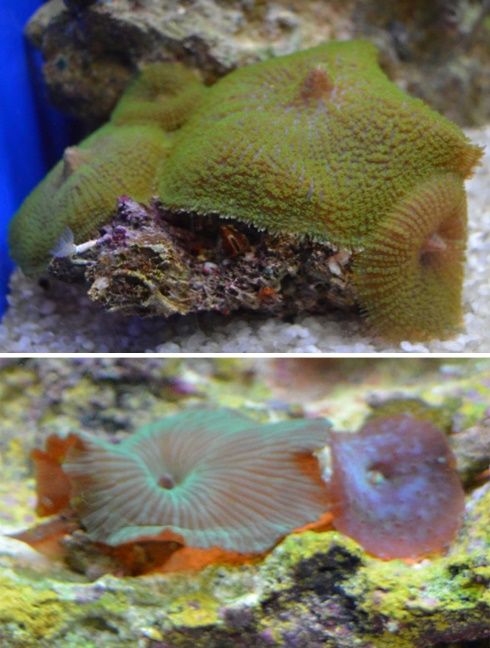
Credit: Prudence Caskey, UF/IFAS
Colonies of Star Polyps (Figure 26) and Zooanthids (Figure 27) are available in a variety of colors. Some variations are more common and for that reason they are more affordable. It is best to begin with an inexpensive colony as your tank is adjusting. Be careful where you place them because they spread.
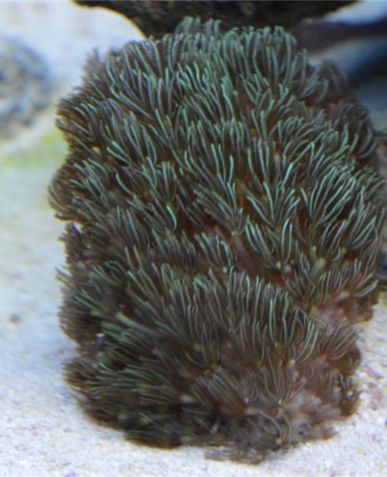
Credit: Prudence Caskey, UF/IFAS
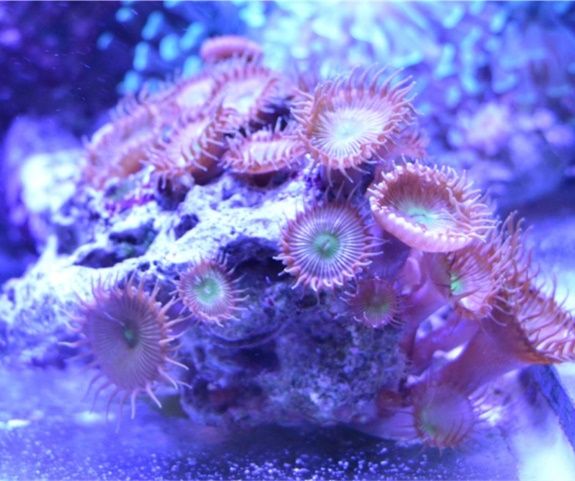
Credit: Prudence Caskey, UF/IFAS
Tree coral is available in many colors. This is a hardy, slow-growing coral that can add color right where you want it! It can also be carefully separated and be attached throughout the tank.
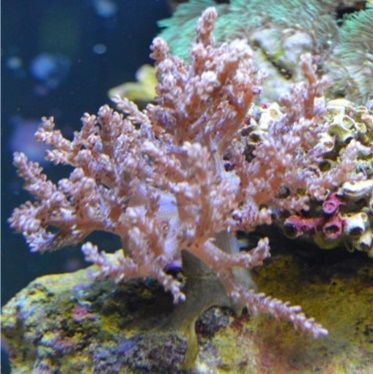
Credit: Prudence Caskey, UF/IFAS
Xenia is an easy-to-grow coral. Russian Blue and Pulsing are two common varieties. Be aware that these corals are inclined to grow so well that they will take over a tank. They will grow on almost every surface and spread quickly. If you want a full tank in no time, they are an excellent choice. Use caution because you may not be able to remove them without draining the tank.
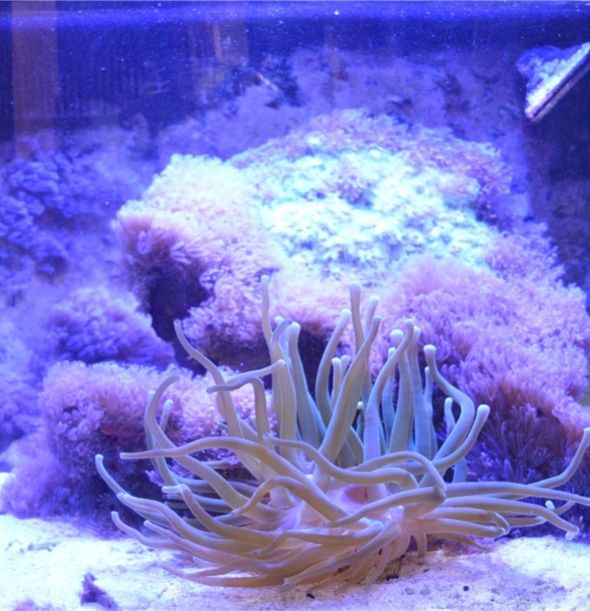
Credit: Prudence Caskey, UF/IFAS
Week Seven: Adding Additional Fish
This week you will select your new fish and add them to the tank. You must pair your fish with the correct type of tank you have. If you decide to have corals, you will need to make sure that you select a reef-safe fish. Many fish fall into this category.
Let’s take a look at how to add your fish.
Always remember to float the fish and any other livestock you add to the tank. This will allow the animals to get used to the temperature before they are released into the tank. Be prepared for them to hide initially. They will come out in time.
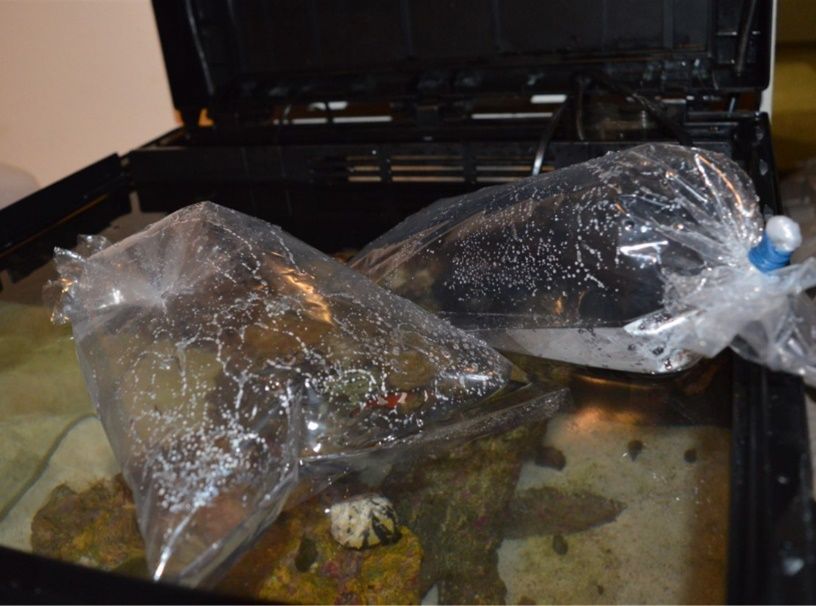
Credit: Prudence Caskey, UF/IFAS
Newly released fish will seek cover until they are comfortable with their new environment. It is best if you can release them later in the day, so that they have some time to get acclimated by morning. Feeding will help bring them out in the open.
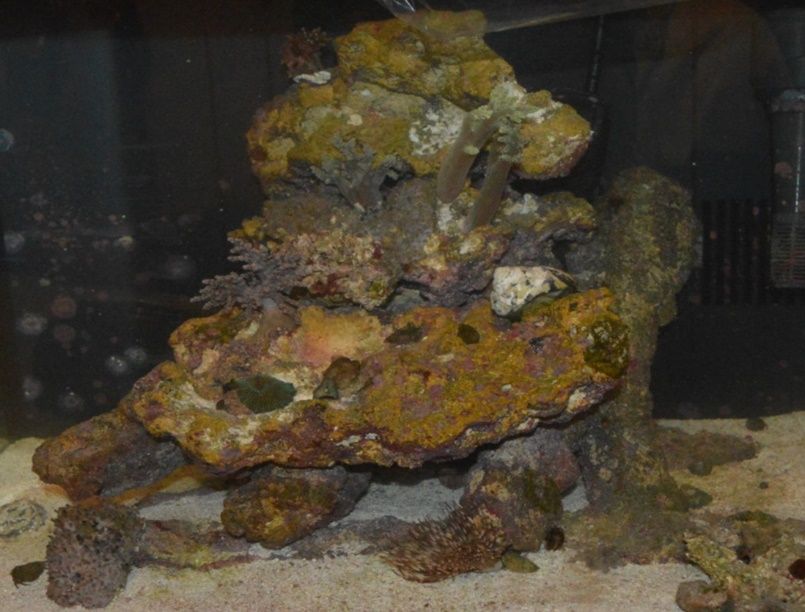
Credit: Prudence Caskey, UF/IFAS
Here is our new clownfish! Don’t expect a clownfish to bond to an anemone. They usually will not because they are bred in tanks and have never seen one!

Credit: Prudence Caskey, UF/IFAS
Fish Identification
Royal Gramma Basslet
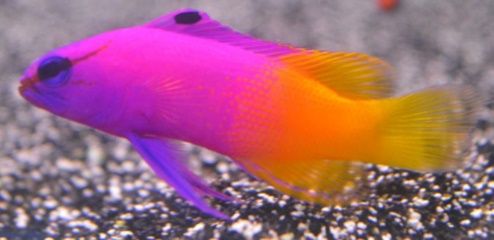
Credit: Prudence Caskey, UF/IFAS
Clownfish
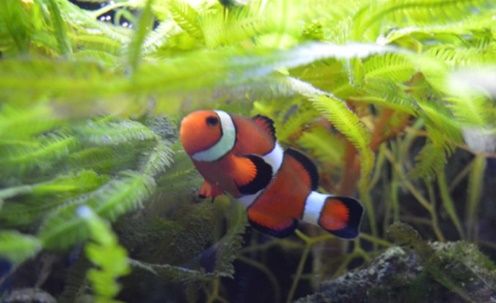
Credit: Prudence Caskey, UF/IFAS
Blue Chromis
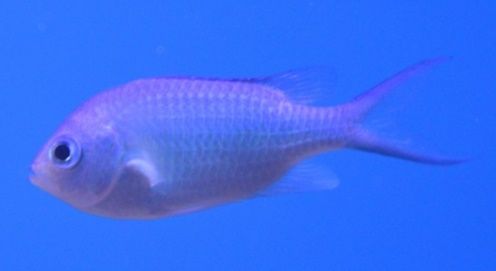
Credit: Prudence Caskey, UF/IFAS
Yellow Head Jawfish
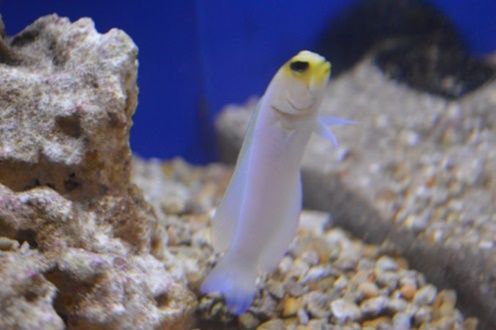
Credit: Prudence Caskey, UF/IFAS
Yellow Angelfish

Credit: Prudence Caskey, UF/IFAS
Yellowtail Damsel
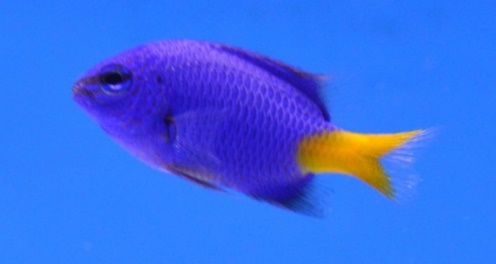
Credit: Prudence Caskey, UF/IFAS
Kupang Damsel

Credit: Prudence Caskey, UF/IFAS
Firefish Goby
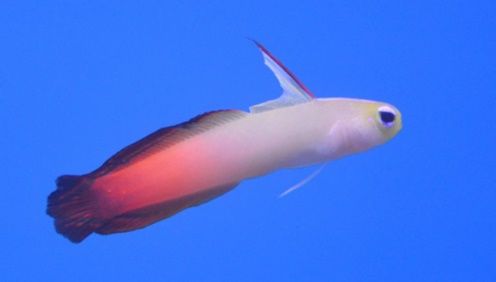
Credit: Prudence Caskey, UF/IFAS
Domino Damsel
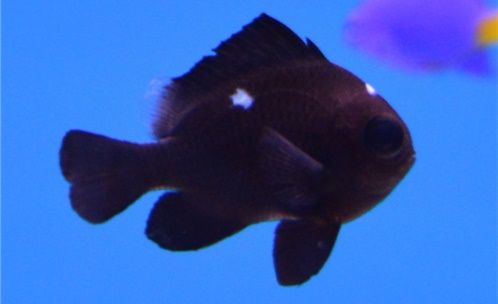
Credit: Prudence Caskey, UF/IFAS
Blue Damsel
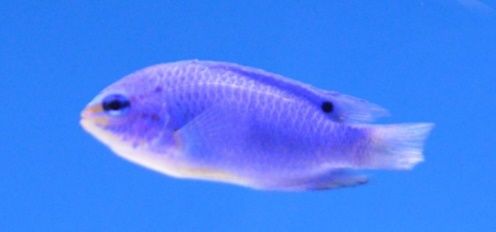
Credit: Prudence Caskey, UF/IFAS
Green Mandarin

Credit: Prudence Caskey, UF/IFAS
Huma Triggerfish $
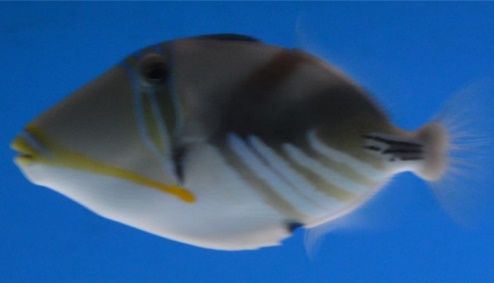
Credit: Prudence Caskey, UF/IFAS
Clown Triggerfish $$
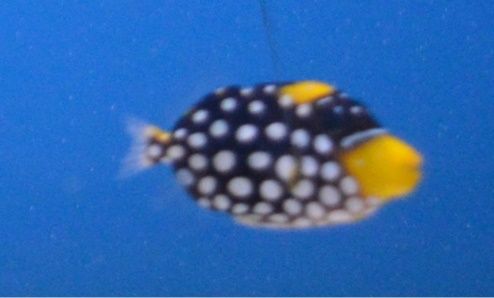
Credit: Prudence Caskey, UF/IFAS
Hawaiian Nasu Tang $$$
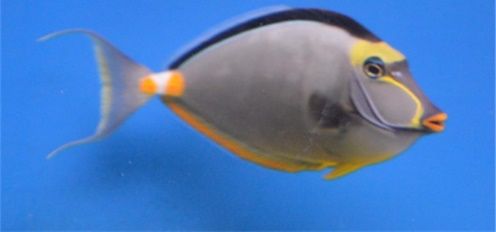
Credit: Prudence Caskey, UF/IFAS
$=Over $50
$$=Over $100
$$$=Over $200
If a fish has no $ next to its name, it costs less than $50.
Week Eight: Testing Equipment
Here is an up-close look at the Sera aqua-test box. This kit will test for pH, ammonia (NH3), nitrites (NO2), nitrates (NO3), iron (Fe), phosphates (PO4), copper (Cu), carbonate hardness (kH), and calcium (Ca). You will commonly only test for the last four on the list if a problem arises. This complete kit retails for about $100. An essential kit is shown on the left. It will test for the first four on the list and costs $50–$75. Most aquarium stores will test your water for little or no cost until you can get your own kit. Test your specific gravity (salinity), pH, ammonia (NH3), nitrites (NO2), and nitrates (NO3) at least every four weeks. With many problems, early detection is key.
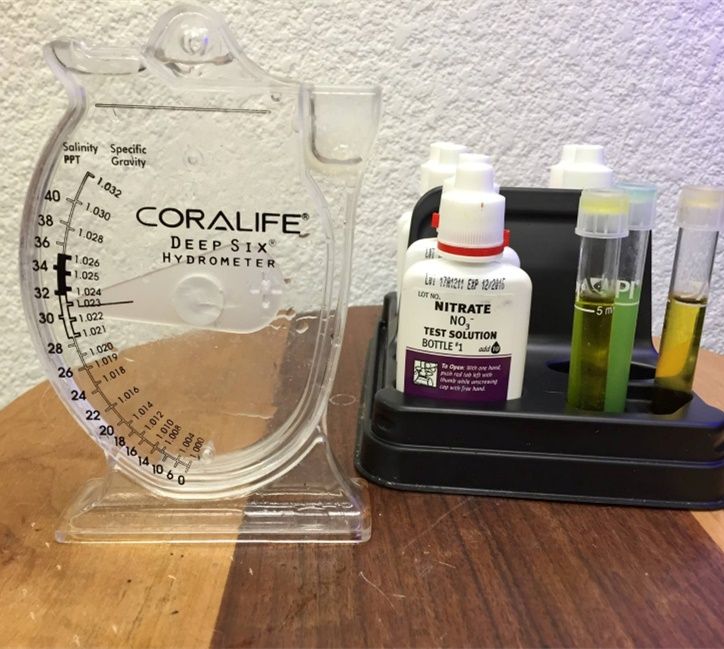
Credit: Prudence Caskey, UF/IFAS
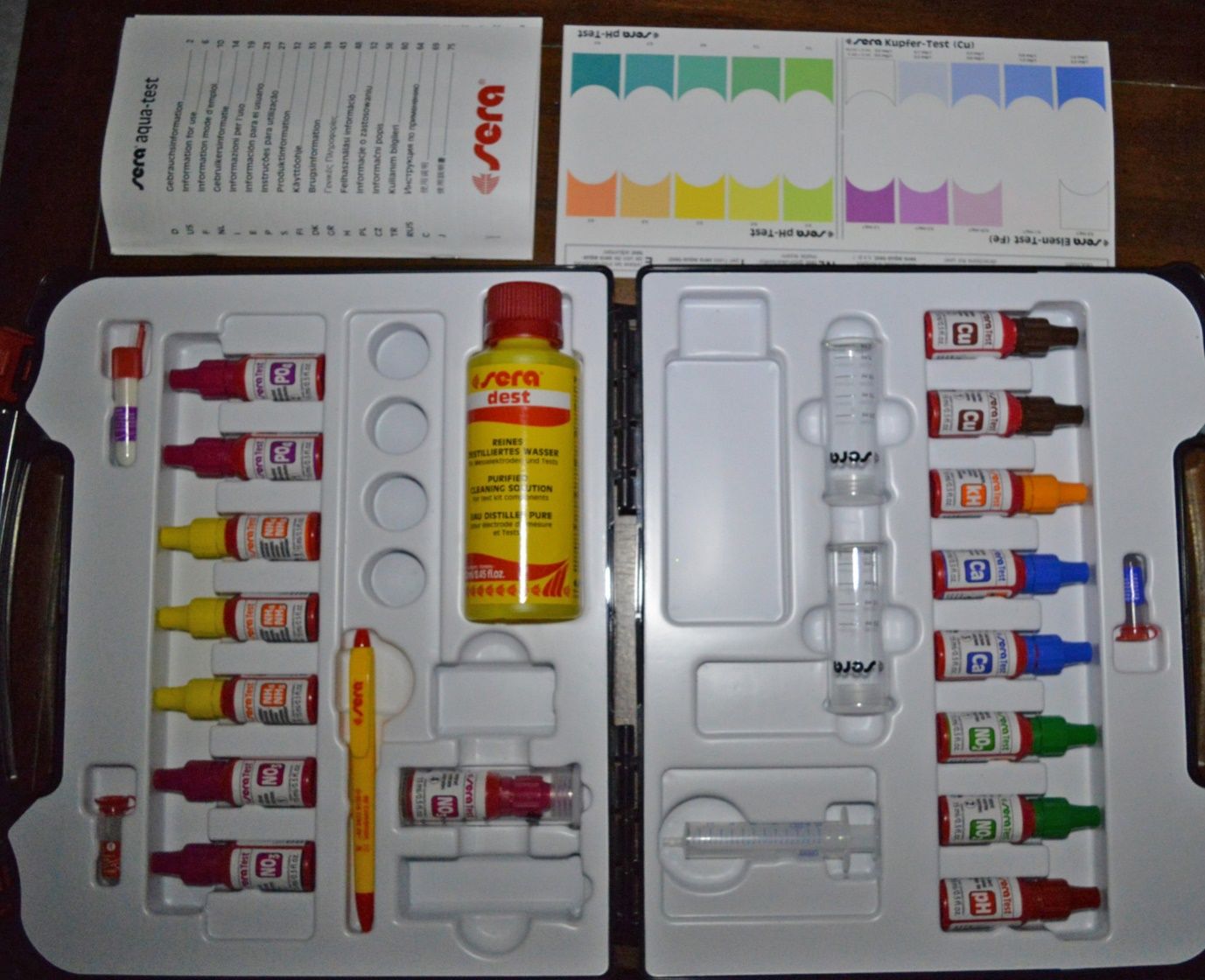
Credit: Prudence Caskey, UF/IFAS
You should test your water every four weeks or if a problem arises.
What Am I Testing For?
Ammonia (NH3): Ammonia naturally occurs when organisms are present in a tank. This is the first step of the nitrogen cycle. As soon as ammonia is presented through waste, the biological conversion to nitrites will begin. The result should be a zero reading.
Calcium (Ca): Corals and other animals use calcium to grow their shells. This level should be between 380–450 ppm (parts per million).
Carbonate Hardness (kH): This is a great combination test to determine if you should test your tank for calcium or magnesium. If your tank has a kH over 8°–12°, you should test calcium and magnesium.
Copper (Cu): A copper test is not run regularly. The result should be zero.
Iron (Fe): This test is not commonly performed. It should be run if problems with algae in your tank arise.
Magnesium (Mg): A magnesium test is performed to diagnose an outbreak of Bryopsis algae. This is a specialty test that can be performed at a fish store. If you have an algae outbreak, a test kit can be purchased for approximately $15–$25 and can be used 30 times.
Nitrite (NO2): Nitrites should have a zero reading after the nitrogen cycle is complete. Bacteria called Nitrosomonas absorb ammonia and release it as nitrites.
Nitrate (NO3): Nitrates are the final stage of waste breakdown. There should be no nitrates in the water after the nitrogen cycle is complete.
pH: This is a measurement of how acidic or base your water is. Monitoring the pH is important if you have animals in your tank that require a more acidic or more basic environment.
Phosphate (PO4): Phosphates are food for algae, and you want to keep them in check. The result should read zero as well. If you have an algae outbreak, check your phosphates.
Salinity: Basically, this is how much salt is in the water. The more salt, the higher the number. This can be expressed in parts per thousand (ppt) or in specific gravity, which is a number between 1.000–1.032. A reef tank should be 34 ppt or have a specific gravity of 1.026.
Temperature: Constantly monitor your temperature, especially if you have a heater. The temperature for a reef tank should be between 76°F–83°F.
Specific Gravity
Specific Gravity measures the amount of salinity or salt within the water. Too much salt in the water will starve the organisms of oxygen. Specific Gravity is measured with a hydrometer which can be purchased at an aquarium store for around $10.
Too Much Salinity

Credit: Prudence Caskey, UF/IFAS
Correct Salinity
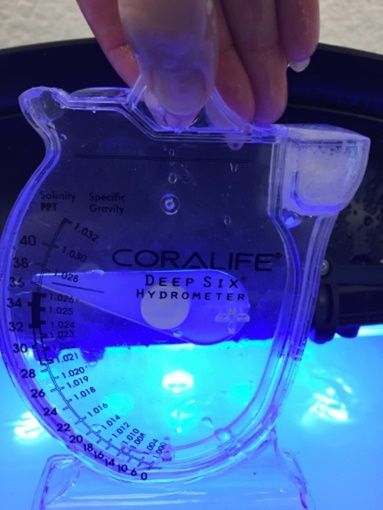
Credit: Prudence Caskey, UF/IFAS
Record Your Findings
Don’t Forget!
As water evaporates from your tank, top off the tank with fresh reverse-osmosis (RO) water only. The salt has not evaporated. If you continue to add saltwater, the salinity will be too high and your tank will suffer the loss of organisms.
Testing Forms
Glossary
Algae: Growths of plantlike organisms. Some algae may look like plants, but they are not plants. There are many different types, shapes and colors of algae.
Alkaline: Refers to the pH of water. Water with a pH higher than 7 is said to be alkaline.
Ammonia: Chemically known as NH3, ammonia is a toxin that can build up in an aquarium. It is released naturally by fish. Ammonia is step one in the nitrogen cycle and is removed by bacterial action, where it is transformed into nitrite. It can also be removed by mechanical filtration.
Aquascaping: The art of designing your aquarium. It involves arranging aquatic plants, rocks, stones, or driftwood. The design is up to the individual and can have unlimited possibilities.
Aragonite: A mineral that contains calcium and is found in rock, gravel, or sand. Aragonite is commonly used in marine and saltwater aquariums.
Bacteria: Bacteria are single-celled, microscopic organisms. Some beneficial bacteria can be used to filter the water by breaking down and consuming waste in an aquarium system.
Ballast: A power source is required for aquarium lights. These are located in the hood.
Bio-Balls: Plastic balls of various sizes that have complex designs. They are used as part of the biological filtration in an aquarium. The more surface area they have, the more area the beneficial bacteria has to grow.
Biological Filtration: Natural filtration for an aquarium that uses bacteria to break down waste as part of the nitrogen cycle.
Bivalve: A shelled animal whose shell is comprised of two halves, usually connected by a flexible hinge. Scallops and clams are examples of bivalves.
Blue-Green Algae: Cyanobacteria forms a blue-green slime that can cover surfaces in an aquarium. This can easily be removed by siphoning during water changes.
Bryopsis Algae: This is a hair-type alga that can come to your tank as a hitchhiker. Be careful where you buy your livestock. Never bring home something from the wild.
Calcareous: Anything containing calcium carbonate. Calcium carbonate is used to help maintain a high pH in aquarium water.
Calcification: The extracting of calcium from the seawater by corals and coralline algae. Calcium is then deposited in the form of calcium carbonate.
Calcium (Ca): A mineral that makes up most corals and other calcareous organisms. In your reef tank, maintain calcium levels between 380 and 480 mg/l (milligrams per liter). This can be achieved through regular water changes and by using calcium additives.
Calcium Carbonate (CaCO3): A chemical compound often used as a calcium supplement. It can be added to aquariums to increase the general hardness (GH) of the water.
Carbon: A substance used for filtration in an aquarium. It is ideal for removing large numbers of toxins in the water as well as maintaining the clarity of the water.
Chemical Filtration: Filtering the water with chemicals such as carbon and protein skimmers is the chemical filtration in the overall filtering system.
Chromatophores: Color pigmentation cells in the skin of marine animals. They are what some fish and invertebrates use to change colors, which allows them to hide from predators.
Compatibility: This refers to how well fish and other animals are likely to get along. Damsels, for instance, can be overly aggressive and should not be overcrowded in a tank. Remember, big fish eat little fish. Use caution when additional animals are introduced to your aquarium.
Copepods: Tiny crustaceans found in marine aquariums. Copepods can reproduce in an aquarium system and make a great source of live food for your fish.
Coral: Marine invertebrates in the class Anthozoa of phylum Cnidaria. Corals commonly live in small colonies of many identical distinct polyps. Some corals secrete calcium carbonate to create a hard skeleton, while others are called soft-bodied corals.
Coralline Algae: A form of algae that creates a calcareous crust like coral. Coralline algae is colorful and can occur in bright pink, purple and red colors. It is sought after in a reef tank and can be made to grow on rocks and desired surfaces by maintaining correct levels of alkalinity, pH, and calcium levels. Because it will also grow on the glass, it can be a struggle to clean. Regular scraping can keep coralline algae under control.
Coral Sand: A white to light-colored sand made up of crushed coral. It can also be called live sand if microorganisms are present.
Crustaceans: Hard-shelled invertebrates including crabs, lobsters, shrimps, and barnacles.
Cyanobacteria: Type of microscopic, photosynthetic organisms that can form large colored mats in an aquarium. Traditionally blue-green in color, they sometimes are red, brown, dark green, or black. Easily removed by siphon during a water change. Testing can determine the cause, and additives can be used to correct the problem.
Diatoms: A single-celled organism that forms brown algae on aquarium glass or rocks. Their shells are formed from silicate, which can be found in nonpurified water. Always use reverse-osmosis (RO) purified water in your aquarium. Never add water from the ocean to a reef tank. There are microscopic diatoms present that will ruin your ecosystem.
Detritus: Waste from aquarium inhabitants. This will accumulate in gray piles in the tank. While siphoning during a water change, detritus can easily be removed. Bumblebee snails are also great for cleaning up detritus.
Filter: There are three main types of filters: biological, chemical, and mechanical. They work differently to remove unwanted particles or compounds from your aquarium’s water.
Filter Medium: Any substance used in water filtration systems to remove impurities or organic wastes from the water. Sponges and Bio-Balls are a couple of examples.
Foam Fractionation: A process of skimming or removing proteins from water using foam. This is the filtration method used by protein skimmers. Many people call it protein skimming; however, foam fractionation is the correct term.
“Frag”: Slang for a coral fragment. A “frag” is a small piece of coral. This can include small colonies of several polyps or a single polyp. Frags are usually mounted on a small piece of metal, plastic or other material, called a frag plug. Frags are a great way to start out in the hobby. New coral can be added to a tank for a relatively inexpensive price. “Frag swaps” are held throughout the country and are an excellent way to add new and exotic corals to your system.
General Hardness (GH): Overall measurement of the concentration of calcium, magnesium, and other ions. It is measured in degrees with the desired range between 5° and 10°. The higher the degree, the harder the water will be.
Gills: Membranes fish use to absorb dissolved oxygen from the water during respiration.
Heater: A standard piece of equipment used to heat the water in an aquarium. Heaters vary in size, wattage, and style. Heaters are an excellent way to maintain the temperature in your aquarium system.
Herbivore: An animal that eats plants. Herbivores are vital to your healthy aquarium because they can assist with keeping algae controlled.
Hydrometer: A device used to measure the specific gravity or salinity of your aquarium.
Impeller: A small fan that is located inside the motor of the pump.
Invertebrate: An animal with no skeleton or backbone. Many animals that live on coral reefs are invertebrates. This includes mollusks, crustaceans, worms, and corals.
Krill: Tiny, shrimplike marine invertebrates. Krill is regularly sold in aquarium stores as live food, frozen or freeze-dried.
Live Rock: Rocks, cultivated from farms, that usually have a variety of sea life attached to or living in them, including nitrifying bacteria, sponges, algae, coralline algae, worms, and starfish. Live rock is commonly used in reef aquariums because it contains beneficial bacteria that can help filter the water through nitrification.
Live Sand: Sand that contains beneficial bacteria and other sea organisms. Live sand is used in reef aquariums because it contains bacteria that can help filter the water through nitrification.
Magnesium: An elemental metal that plays a critical role in the chemical and biological processes in the marine aquarium. Magnesium is important for the skeleton-forming process of stony corals and other invertebrates.
Marine Aquarium: An aquarium that keeps marine plants and animals in a contained environment. Also known as a saltwater aquarium, a marine aquarium is usually set up to reproduce a marine environment such as a coral reef.
Mechanical Filtration: A water filtration method that uses a filtering medium to remove particles from the water.
Microalgae: Small microscopic types of algae such as the green algae and hair algae often present in marine aquariums.
Nano Reef: A small marine aquarium that is typically less than 20 gallons. Nano reefs can be more challenging to keep because of the small water volume.
Nitrate (NO3): The final product in the nitrogen cycle. There should be no nitrates in the water after the nitrogen cycle is complete.
Nitrification: The progression by which bacteria change ammonia into nitrite and then nitrite into nitrate. This is the basis of the nitrogen cycle.
Nitrifying Bacteria: Naturally occurring bacteria that change ammonia or ammonium into nitrite or change nitrite into nitrate as part of the nitrogen cycle. Nitrifying bacteria are a key component of a biological filter for an aquarium.
Nitrite (NO2): Bacteria called Nitrosomonas absorb ammonia and release it as nitrites. Nitrites should have a zero reading after the nitrogen cycle is complete.
Nitrogen Cycle: The nitrogen cycle is the natural process through which nitrogen is incorporated into food by photosynthetic organisms. These organisms are consumed directly or indirectly by other organisms and subsequently excreted, acted upon by bacteria, and made available again for plant nutrition.
Oxygen Reduction Potential (ORP): A simple measurement of the water's ability to cleanse itself.
Parasite: An organism that nourishes itself with the tissues of another organism. Parasites are one of the main reasons for disease in aquariums.
pH: A measurement of how acidic or basic your water is. Monitoring the pH is important if you have animals in your tank that require a more acidic or more basic environment.
Phosphate: A nutrient that can cause uncontrolled growth of algae in the aquarium. It can also be toxic in high concentrations and must be kept to a minimum in coral-reef aquariums. Phosphate can be easily removed by a number of commercially available filter media.
Photoperiod: The amount of time each day that the aquarium lights are turned on.
Phytoplankton: Microscopic plants found drifting in saltwater. Phytoplankton embodies the bottom of the food chain in the ocean.
Plankton: A general term used to denote both phytoplankton and zooplankton.
Powerhead: A small pump that is fully submersible. It is used inside an aquarium to provide water movement to simulate wave movement.
Protein Skimmer: An additional filtering device that uses bubbles to create foam and remove organic wastes from the aquarium. This is an essential piece of equipment for maintaining good water quality in a reef tank.
Quarantine Tank: Often called a hospital tank. This is a separate tank that allows for sick or injured fish to be placed away from the rest of the healthy fish. This allows the injured or sick fish time to heal without spreading disease or becoming the victim of more aggressive fish.
Reverse Osmosis (RO): An advanced procedure for filtering water for use in an aquarium. This technique works by pushing water under pressure through a special membrane. Reverse osmosis can produce very pure water, but it is a slow process and can only filter small amounts at a time. Many aquarium stores make RO water available for purchase. RO water can be fresh for topping off after evaporation or ready-to-add RO saltwater.
Salinity: The amount of salt in seawater, measured in parts per thousand (ppt). Natural seawater has a salinity of about 35 ppt.
Siphon: A length of tube that can use gravity to move water from one location to another. This is the best way to remove water from your marine aquarium during a water change. The siphon hose can be used to target and remove nuisance algae during a water change.
Specific Gravity: The proportion of concentration of salt in a given liquid to that of pure water. Specific gravity is used to measure the salinity of seawater as compared to distilled water. Distilled water has a specific gravity of 1.000, while natural seawater has a S.G. of about 1.025. Marine aquariums should have a specific gravity of 1.026.
Sponge Filters: A type of filter that provides both mechanical and biological filtration. Particles are removed from the water as it passes through the sponge. Microorganisms growing on the surface of the sponge also eradicate toxic substances from the water.
Sweeper Tentacles: Some aggressive hard corals use these extended stinging appendages to sting other nearby corals to gain territory and growing space.
Symbiotic: A phenomenon where two different organisms live together in a mutually beneficial relationship. Both creatures provide each other with food, protection, or some other survival need. An excellent example in the wild is an anemone and clownfish. The anemone offers the clownfish protection within its stinging tentacles, and the clownfish delivers the anemone scraps of food. In the marine aquarium, clownfish often do not pair with anemones. The main reason is that clownfish raised in captivity are not exposed to anemones at an early age.
Trace Elements: Elements that naturally occur in trivial quantities in your aquarium. These are required for survival by many reef organisms and include barium, calcium, iodine, lithium, molybdenum, and strontium.
Trickle Filters: A purification system where water is dripped over a filter medium that is exposed to the air. The air aids to improve the nitrification process. The filter medium usually consists of small plastic balls or strips of plastic. Bio-Balls are used in the systems we discuss in this project book.
Turnover: The amount of water that is filtered by a system. The higher the turnover rate, the more beneficial it is for reef tanks.
Vertebrate: Animals that have a backbone and a skeleton. For our purposes, this includes fish, sharks, and jawless fish.
Water Change: The practice of swapping a portion of aquarium water with a fresh saltwater mix. It is suggested that 20 to 25 percent of the water be changed each month in a reef tank. Remember to add only reverse-osmosis (RO) water back to the system at this time. This is an excellent way to remove a large number of impurities in a short amount of time.
Wet/Dry Filter: Part of the biological filtration system that is exposed to the air to aid in the nitrification process. This system is contained in chamber 2 of our aquarium system. Water flows down into the filter and over a filter medium, where microorganisms remove pollutants. The water is then pumped back up into the tank. A mechanical filtration medium may also be used in a wet/dry filter.
Zooplankton: Tiny microscopic animals often present in seawater. The larval stages of many fishes and invertebrates are included in this category.
Zooxanthellae: Tiny plants that live in a symbiotic relationship with certain corals, clams, and some sponges. They receive nutrients from their host and provide a food source in return. They are the reason for the brilliant colors in corals and clams.
Your 4-H Story
Record your experience during this project.
Project Photos
[attach photos here]
Answer Keys
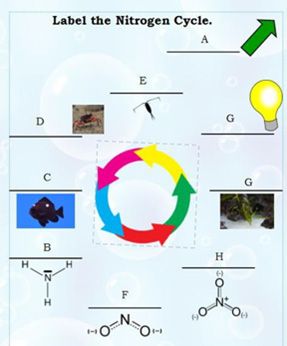
Credit: Prudence Caskey, UF/IFAS
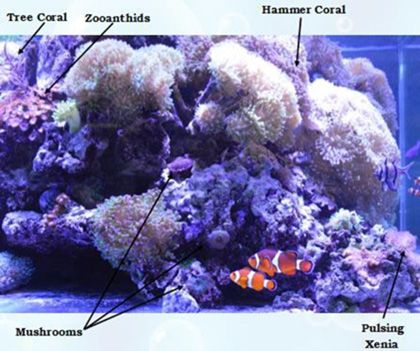
Credit: Prudence Caskey, UF/IFAS
Additional Resources
Electronic Data Information Sources
4-H Member's Guide: Starting and Maintaining a Marine Aquarium http://agrilife.org/fisheries2/files/2013/10/Starting-and-Maintaining-a-Marine-Aquarium.pdf
Websites
Marine Aquarium Societies of North America http://www.masna.org
Reef2Reef http://www.reef2reef.com/
Florida Marine Aquarium Society http://www.fmas1955.org
Books and Publications
Coral Magazine http://www.coralmagazine.com/
The Coral Reef Aquarium: From Inception to Completion (Oceanographic Series) by Tony Vargas (Author), Julian Sprung (Editor) ISBN-10: 1883693306ISBN-13:978-1883693305
Reef Hobbyist Magazine http://www.reefhobbyistmagazine.com/
Works Cited
"Glossary of Aquarium Terms." - Saltwater Aquarium Guide on Sea and Sky. N.p., n.d. Web. 21 July 2016.
"Reef2Reef Forums." Reef2Reef Forums. N.p., n.d. Web. 2015.
4-H Pledge
I pledge my head to clearer thinking, My heart to greater loyalty, My hands to larger service, and My health to better living for my club, my community, my country, and my world